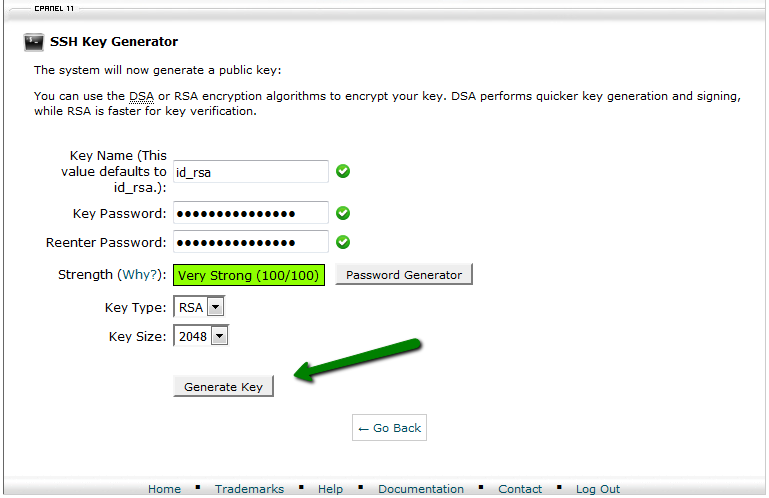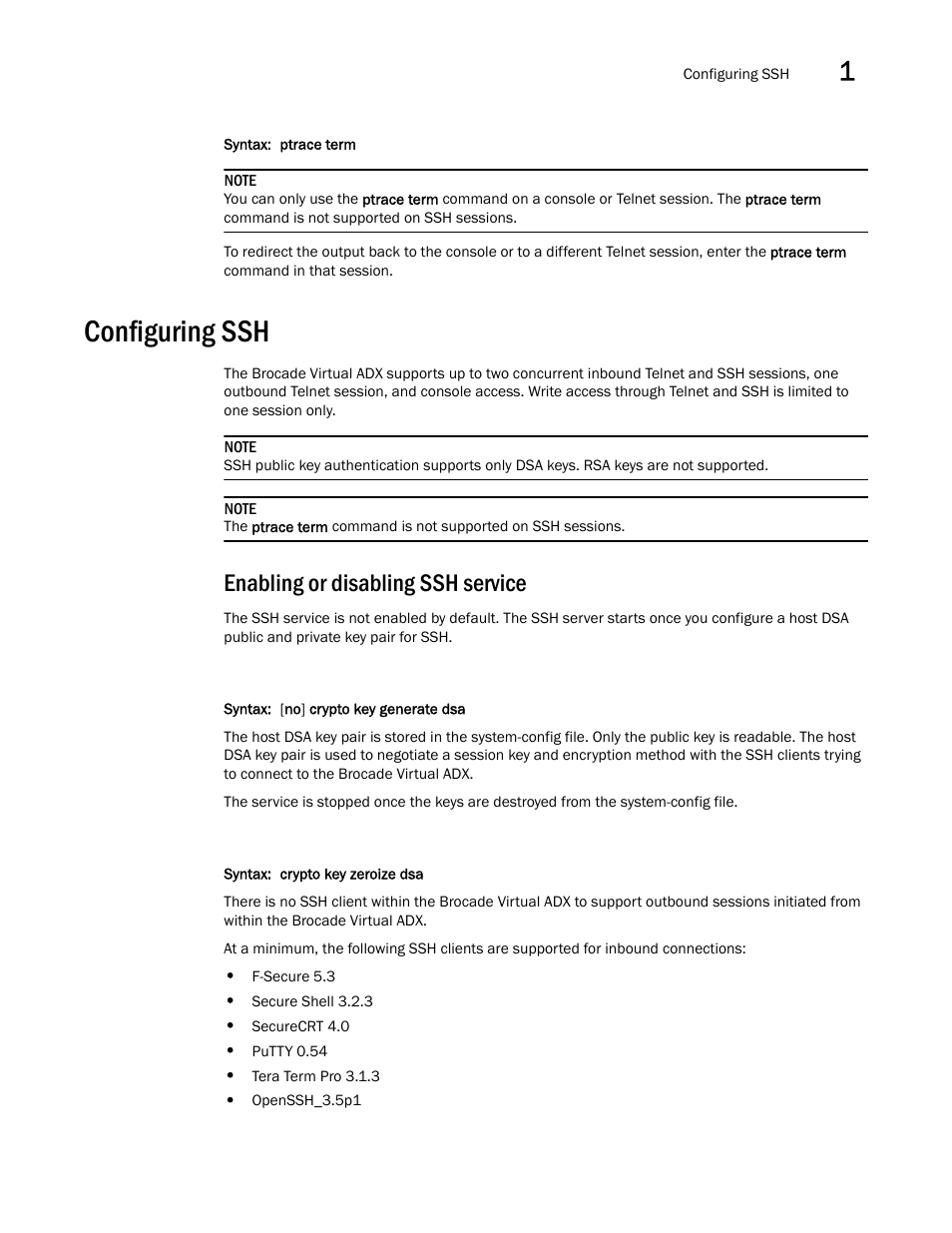-->
Creating and managing keys is an important part of the cryptographic process. Symmetric algorithms require the creation of a key and an initialization vector (IV). The key must be kept secret from anyone who should not decrypt your data. The IV does not have to be secret, but should be changed for each session. Asymmetric algorithms require the creation of a public key and a private key. The public key can be made public to anyone, while the private key must known only by the party who will decrypt the data encrypted with the public key. This section describes how to generate and manage keys for both symmetric and asymmetric algorithms.
Symmetric Keys
RSA is generally preferred (now that the patent issue is over with) because it can go up to 4096 bits, where DSA has to be exactly 1024 bits (in the opinion of ssh-keygen). 2048 bits is ssh-keygen 's default length for RSA keys, and I don't see any particular reason to use shorter ones. RSA the Key Generation Example 1. Randomly choose two prime numbers pand q. We choose p= 11 and q= 13. Compute n= pq. We compute n= pq= 1113 = 143.
The symmetric encryption classes supplied by the .NET Framework require a key and a new initialization vector (IV) to encrypt and decrypt data. Free vst plug-ins. Whenever you create a new instance of one of the managed symmetric cryptographic classes using the parameterless constructor, a new key and IV are automatically created. Anyone that you allow to decrypt your data must possess the same key and IV and use the same algorithm. Generally, a new key and IV should be created for every session, and neither the key nor IV should be stored for use in a later session.
To communicate a symmetric key and IV to a remote party, you would usually encrypt the symmetric key by using asymmetric encryption. Sending the key across an insecure network without encrypting it is unsafe, because anyone who intercepts the key and IV can then decrypt your data. For more information about exchanging data by using encryption, see Creating a Cryptographic Scheme.
The following example shows the creation of a new instance of the TripleDESCryptoServiceProvider class that implements the TripleDES algorithm.
When the previous code is executed, a new key and IV are generated and placed in the Key and IV properties, respectively.
Sometimes you might need to generate multiple keys. In this situation, you can create a new instance of a class that implements a symmetric algorithm and then create a new key and IV by calling the GenerateKey and GenerateIV methods. The following code example illustrates how to create new keys and IVs after a new instance of the symmetric cryptographic class has been made.
Roland promars vst crack mac. When the previous code is executed, a key and IV are generated when the new instance of TripleDESCryptoServiceProvider is made. Another key and IV are created when the GenerateKey and GenerateIV methods are called.
Asymmetric Keys
Ssh Key Dsa Or Rsa
The .NET Framework provides the RSACryptoServiceProvider and DSACryptoServiceProvider classes for asymmetric encryption. These classes create a public/private key pair when you use the parameterless constructor to create a new instance. Asymmetric keys can be either stored for use in multiple sessions or generated for one session only. While the public key can be made generally available, the private key should be closely guarded.
A public/private key pair is generated whenever a new instance of an asymmetric algorithm class is created. After a new instance of the class is created, the key information can be extracted using one of two methods:
The ToXmlString method, which returns an XML representation of the key information.
The ExportParameters method, which returns an RSAParameters structure that holds the key information.
Decorate your restaurants to attract more clients. Oh, and did we say that this game is as addictive and as engrossing as fever? Make your own freebies, such as cookies or cupcakes, to make your customers’ experience more personal and memorable – just like in real life! Free windows 10 download for xp. Upgrade your kitchen and produce an even greater variety of dishes.
Both methods accept a Boolean value that indicates whether to return only the public key information or to return both the public-key and the private-key information. An RSACryptoServiceProvider class can be initialized to the value of an RSAParameters structure by using the ImportParameters method.
As promised, Apple has included a new screen in the iOS 11.3 settings called Battery Health (Beta) available on all iPhones since iPhone 6. 3utools battery health software.

Asymmetric private keys should never be stored verbatim or in plain text on the local computer. If you need to store a private key, you should use a key container. For more on how to store a private key in a key container, see How to: Store Asymmetric Keys in a Key Container.
The following code example creates a new instance of the RSACryptoServiceProvider class, creating a public/private key pair, and saves the public key information to an RSAParameters structure.
See also
How to Generate a Public/Private KeyPair for Use With Solaris Secure Shell
Users must generate a public/private key pair when their site implementshost-based authentication or user public-key authentication. For additionaloptions, see the ssh-keygen(1) manpage.

Before You Begin
Rsa And Dsa Key Generation Brocade Code
Determine from your system administrator if host-based authenticationis configured.
Start the key generation program.
where -t is the type of algorithm, one of rsa, dsa, or rsa1.
Specify the path to the file that will hold the key.
Bydefault, the file name id_rsa, which represents an RSAv2 key, appears in parentheses. You can select this file by pressing the Return key. Or, you can type an alternative file name.
The file name of the public key is created automatically by appendingthe string .pub to the name of the private key file.
Type a passphrase for using your key.
This passphraseis used for encrypting your private key. A null entry is stronglydiscouraged. Note that the passphrase is not displayed when youtype it in.
Retype the passphrase to confirm it.
Check the results.
Check that the path to the keyfile is correct.
At this point, you have created a public/private key pair.
Choose the appropriate option:
If your administrator has configuredhost-based authentication, you might need to copy the local host's publickey to the remote host.
You can now log in to the remote host.For details, see How to Log In to a Remote Host With Solaris Secure Shell.
Type the command on one line with no backslash.
When you are prompted, supply your login password.
If your site uses user authentication with public keys, populateyour authorized_keys file on the remote host.
Copy your public key to the remote host. Dev c++ run a program with arguments.
Type thecommand on one line with no backslash.
When you are prompted, supply your login password.
Whenthe file is copied, the message “Key copied” is displayed.
(Optional) Reduce the prompting for passphrases.
For a procedure, see How to Reduce Password Prompts in Solaris Secure Shell. For more information, see the ssh-agent(1) and ssh-add(1) man pages.
Example 19–2 Establishing a v1 RSA Key for a User
In the following example, the user cancontact hosts that run v1 of the Solaris Secure Shell protocol. To be authenticated by v1hosts, the user creates a v1 key, then copies the public key portion to theremote host.